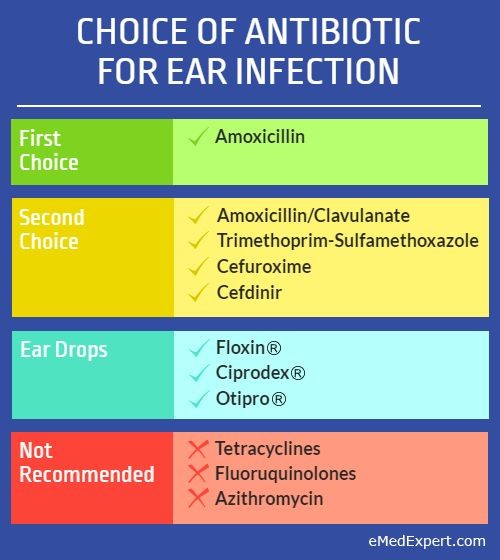
Contents
Which Antibiotic Is Best for An Ear Infection?
Ototopical antibiotics are topically administered to treat middle ear infections and are the preferred first-line treatment for recurrent bacterial ear infections, without systemic infection.
Ear infections are more common in children and often resolve on their own. Warm compresses and pain management are usually sufficient for most cases. Antibiotics are reserved for severe and persistent ear infections.
Advantages of Ototopical Antibiotics
Ototopical antibiotics offer several advantages over systemic delivery:
High Antibiotic Concentration
- Topical antibiotic solutions contain significantly higher concentrations than oral or intravenous medications. The direct administration of these high concentrations at the site of infection is more effective in killing bacteria and reduces the likelihood of developing antibiotic-resistant strains.
- The minimum inhibitory concentration (MIC) is the lowest level of drug concentration needed to prevent bacterial growth. Ototopical antibiotics surpass the MIC required to destroy even highly resistant bacteria.
Absence of Systemic Effects
- Topical administration eliminates the risk of systemic antibiotic side effects and preserves the normal beneficial bacteria in the respiratory and gastrointestinal tracts. It also prevents the proliferation of drug-resistant bacteria.
Alteration of Microenvironment
- Topical administration allows for the alteration of the ear canal’s microenvironment, making it inhospitable for bacterial growth. By delivering the antibiotic in an acidic solution, the natural defense mechanism of the ear canal can be enhanced.
Cost-Effective Treatment
- Ototopical antibiotics are generally more affordable than comparable systemic medications.
Disadvantages of Ototopical Antibiotics
Ototopical antibiotics do have a few disadvantages:
Difficult Administration
Delivering antibiotics directly to the infection site may be challenging or impossible if the ear canal is blocked due to excessive earwax, discharge, or swollen tissue. Blockages must be cleared before antibiotic administration.
Inflammation and Complications
Ototoxicity can irritate and inflame the middle ear’s mucus membranes. If the antibiotic enters the inner ear, it may lead to ototoxicity. Allergic reactions to ototopical antibiotics can cause persistent drainage, making treatment difficult. Some individuals may develop cross-sensitivity to related antibiotics.
Absence of Systemic Effect
- Absence of systemic effect can become a disadvantage if the infection spreads outside the ear canal, requiring treatment with systemic antibiotics.
- If the ear infection is accompanied by a sinus or throat infection, systemic antibiotics will be necessary.
Alteration of Microenvironment
- Alterations to the ear’s microenvironment can be counterproductive. While most bacteria grow best in a neutral pH, some thrive in acidic or alkaline conditions. Antibiotics administered in an alkaline solution can create a hospitable environment for bacteria that prefer alkaline conditions.
Types of Ototopical Antibiotics
Ototopical antibiotics come in three forms:
Powders
Powders are not FDA-approved but have been in use for years. They adhere well to moist surfaces. Two commonly used powders are "Gold dust" and "Mastoid powder."
Creams and Ointments
Creams and ointments are only used for bacterial and fungal infections in the external ear and auditory canal. Examples include Neomycin/polymyxin B/bacitracin, Tobramycin ointment, Clotrimazole, and Mupirocin ointment.
Drops
Drops are the most commonly used form of ototopical antibiotics and come as single agents or combination products. Some drops contain steroids or antiseptics, while others rely on pH and viscosity to control bacterial growth.
Which Antibiotic Is Best for an Ear Infection?
Two classes of antibiotics are commonly used:
Aminoglycosides
Aminoglycosides have been the main treatment for bacterial ear infections for decades. The most commonly used aminoglycosides in ototopical preparations are Neomycin and Tobramycin.
Quinolones
Fluoroquinolones, considered the best treatment for ear infections, offer a broad spectrum of activity against gram-positive and gram-negative bacteria without ototoxicity. Examples include Ciprofloxacin, Finafloxacin, and Ofloxacin.
Proper antibiotic selection depends on the specific infection and individual patient factors.
Summary
Ototopical antibiotics are the preferred treatment for middle ear infections. They offer advantages such as high antibiotic concentration, absence of systemic effects, alteration of the ear’s microenvironment, and cost-effectiveness. However, they also have disadvantages like difficult administration, inflammation risk, absence of systemic effect in severe infections, and potential alteration of the microenvironment. Aminoglycosides and quinolones are the primary antibiotic classes used for ear infections.


